Nevada’s territory consists of mountainous ranges and is part of the Great Basin. It has a semi-arid and desert climate, meaning not all plants and animals can survive here. Still, the state is abundant in wildlife, hosting many animal and plant species.
Nevada’s state flower is the Artemisia tridentata, commonly called big sagebrush or Great Basin sagebrush – an aromatic shrub growing across the Great Basin. However, besides the big sagebrush, Nevada is home to many other plants. Even more, some of them are endemic to the state.
As such, if you’re planning to visit Nevada soon and explore its desert and semi-arid regions, we’ve prepared a list of some plants native to the state, including one that’s the most poisonous in North America! Keep reading to learn some key facts about each species!
What Is a Native Plant?
Native plants are recognized as the species of flora that have been naturally growing in a region for thousands of years (or more). Another term often used to describe native plants is indigenous. Such a plant is essentially a part of a region’s ecosystem and not only fits but also thrives there.
Regarding characteristics, native implies perfect adaptation to the region’s ecosystem, soil conditions, light, and climate.
11 Native Plants in Nevada
1. Spring-Loving Centaury
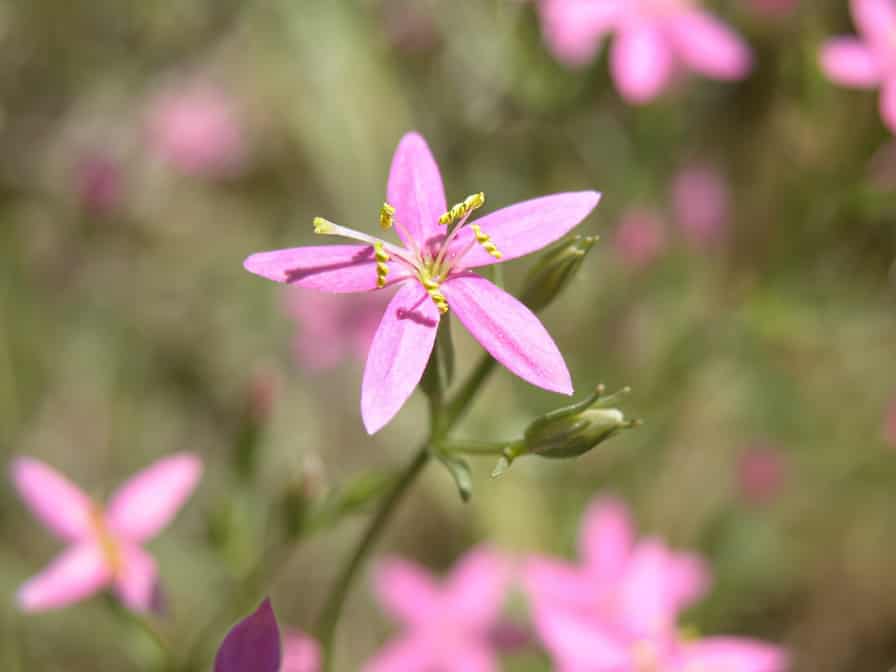
The spring-loving centaury flowering herb is endemic to Nevada.
©public domain – License
| Spring-Loving centaury | |
|---|---|
| Scientific name | Zeltnera namophila |
| Type of plant | Annual flowering herb |
| Distribution | Amargosa Valley, Nye County, Nevada |
The spring-loving centaury flowering herb is endemic to Nevada – that is, to the Ash Meadows National Wildlife Refuge in the Amargosa Valley, Nye County. The territory hosts six plant populations that include more than four million specimens. Although it sounds like good news, this number isn’t too significant for a plant population, especially when hydrology alterations threaten it.
The plant has a 1.4-foot-tall branching stem that bears deep pink flowers from July to September. The spring-loving centaury produces capsule fruits that contain 50 seeds.
2. Meadow Lotus

The meadow lotus has an upright stem bearing leaves equipped with three elongated oval leaflets.
©Merrie Freed / Public domain, via Wikimedia Commons – License
| Meadow Lotus | |
|---|---|
| Scientific name | Hosackia oblongifolia |
| Other common names | Streambank bird’s-foot trefoil |
| Type of plant | Perennial herb |
| Distribution | Western North America |
Native to western North America, the meadow lotus can be found all the way from Oregon to northern Mexico, thriving in moist to wet areas. People often refer to it as the streambank bird’s-foot trefoil.
The plant has an upright stem bearing leaves equipped with three elongated oval leaflets. The inflorescences have a distinctive shape, bearing yellow and white flowers. However, the flowers are quite small, never growing over 0.8 inches long. The elongated fruits, on the other hand, can reach 1.9 inches long.
3. Sierra Juniper
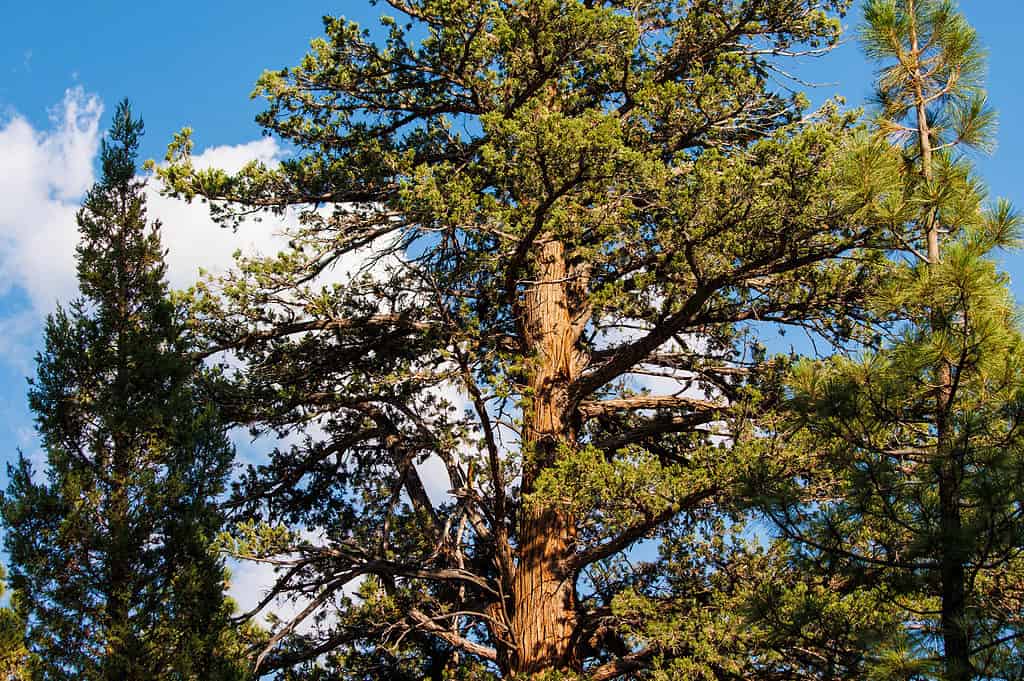
The Sierra juniper has a distinctive shape and unique leaves, which are scale-like and whorled.
©iStock.com/Jared Quentin
| Sierra Juniper | |
|---|---|
| Scientific name | Juniperus grandis |
| Other common names | Sierra western juniper, western juniper |
| Type of plant | Evergreen |
| Distribution | Western United States |
The Juniperus grandis species is considered the fourth longest-living tree species! This statement is based on the 2,675-year-old Scofield Juniper!
Although it’s one of the world’s longest-living trees, the Sierra juniper doesn’t reach extraordinary heights, usually growing only up to 85 feet tall. Still, it has a distinctive shape and unique leaves, which are scale-like and whorled. The berry-like cones are fleshy, while the seeds are wingless.
The Sierra juniper grows on dry, rocky slopes and is often found in temperate coniferous forests in California and Nevada.
4. Gray’s Bedstraw

The Gray’s bedstraw is a mat-forming perennial that grows on mountain slopes.
©Tom Hilton / CC BY 2.0 – License
| Gray’s Bedstraw | |
|---|---|
| Scientific name | Galium grayanum |
| Type of plant | Mat-forming perennial herb |
| Distribution | California, Nevada, Oregon |
California, Nevada, and Oregon are the only states in the U.S. that host Gray’s bedstraw, a mat-forming perennial that grows on mountain slopes. The plant’s stems can grow up to 7.8 inches tall and feature whorled leaves growing in groups of four. Gray’s bedstraw leaves are velvety and fleshy and have an oval shape and pointed tips. When in bloom, the plant produces yellow-reddish flowers that grow at the end of the stem.
Of the two recognized subspecies, only the Galium grayanum var. nanum grows in Nevada and is found in Mt. Rose Wilderness in Washoe County.
5. Cutleaf Silverpuffs

The cutleaf silverpuffs grows from Washington to California and Nevada.
©Bureau of Land Management Bureau of Land Management / CC BY-SA 2.0 – License
| Cutleaf Silverpuffs | |
|---|---|
| Scientific name | Microseris laciniata |
| Type of plant | Perennial herb |
| Distribution | Western United States |
The cutleaf silverpuffs thrives in forests and grasslands, producing gorgeous flower heads with more than 100 long yellow ray florets! Its leaves can reach 19.6 inches long and have lobed, toothed, or smooth edges. This plant produces gray or brown fruits called achenes, which have a pappus that contains up to 20 elongated, hairy scales.
The cutleaf silverpuffs grows from Washington to California and Nevada.
6. Western Bristlecone Pine
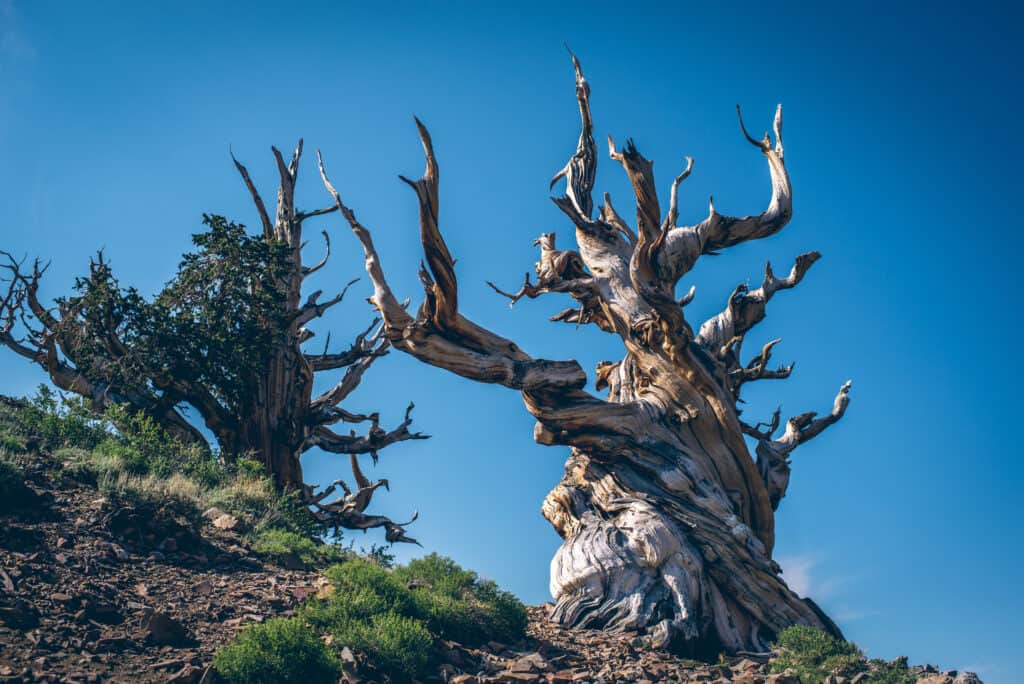
The western bristlecone pine usually reaches only 49 feet in height.
©doliux/Shutterstock.com
| Western Bristlecone Pine | |
|---|---|
| Scientific name | Pinus longaeva |
| Other common names | Great Basin bristlecone pine, intermountain bristlecone pine |
| Type of plant | Bristlecone pine tree, evergreen |
| Distribution | California, Nevada, Utah |
What if we told you that the Earth’s “oldest known living non-clonal organism” is a western bristlecone pine called Methuselah, and it’s 4,854 years old?! Methuselah is found in eastern California. However, these trees grow in Nevada and Utah, too. In some areas, including the Great Basin National Park in Nevada, the trees are protected by the United States federal government.
The tree isn’t very tall, as it usually reaches only 49 feet in height. Thanks to its bright orange-yellowish color, it has a distinctive bark, and the tree needles are deep blue or blue-green. The cones, on the other hand, can be green or purple but become orange when they ripen.
7. Palmella
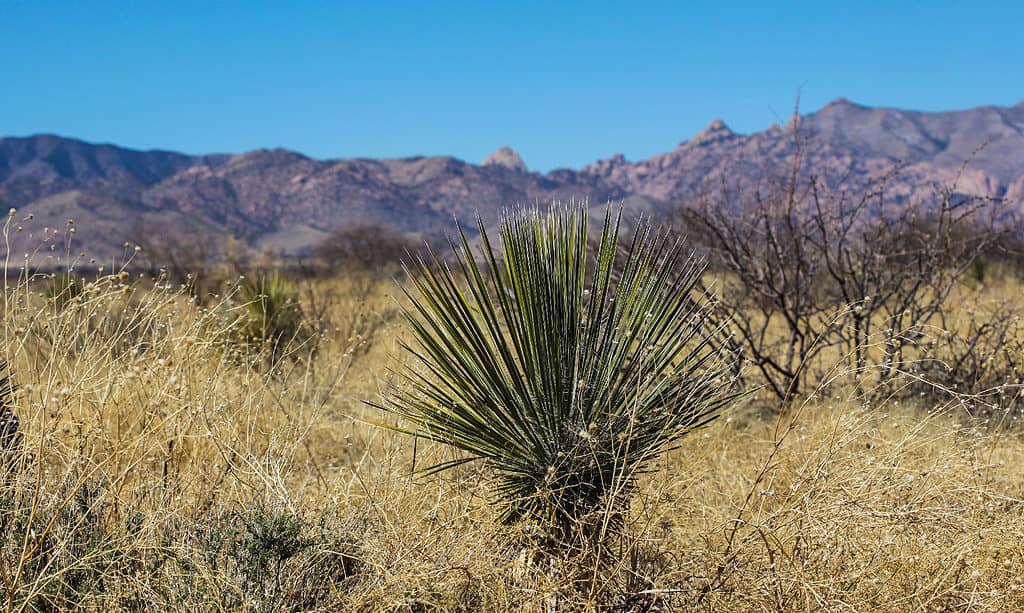
The palmella grows best in dry, semi-desert habitats.
©Ingrid Curry/Shutterstock.com
| Palmella | |
|---|---|
| Scientific name | Yucca elata |
| Other common names | Soaptree, soapweed, soaptree yucca |
| Type of plant | Perennial plant |
| Distribution | Southwestern North America |
The palmella gets its scientific name because of the yucca moths that drill holes in its trunk while trying to escape. Yucca elata perennial plant has a brown trunk that’s slender and cylindrical. Its leaves are long, reaching 37 inches, and arranged in spiral whorls.
When in bloom, the palmella produces white flowers that appear in dense clusters in bell-like shapes. Sometimes the flowers have pink or green shades. Unfortunately, the soaptree doesn’t bloom every year.
The palmella grows best in dry, semi-desert habitats. In Nevada, the plant can be found in the southern regions, where they thrive in plenty of sunlight.
8. Mason’s Sky Pilot

The Mason’s sky pilot can be found at high elevations in habitats like alpine fellfields and talus.
©James Morefield / public domain – License
| Mason’s Sky Pilot | |
|---|---|
| Scientific name | Polemonium chartaceum |
| Other common names | Mason’s Jacob’s ladder |
| Type of plant | Flowering perennial herb |
| Distribution | California, Nevada |
Like other plants on our list, the Mason’s sky pilot is native to California, extending into Nevada. It can be found at high elevations in habitats like alpine fellfields and talus.
The plant’s stems aren’t very tall, growing only up to 7.8 inches tall, and hold clustered leaves at the base. The flowers bloom in a head-like cluster at the top of the stem. They have pale blue-purplish shades and have yellow or white throats.
This plant is listed as Critically Imperiled, meaning it’s at risk of extinction.
9. Hairy Milkweed
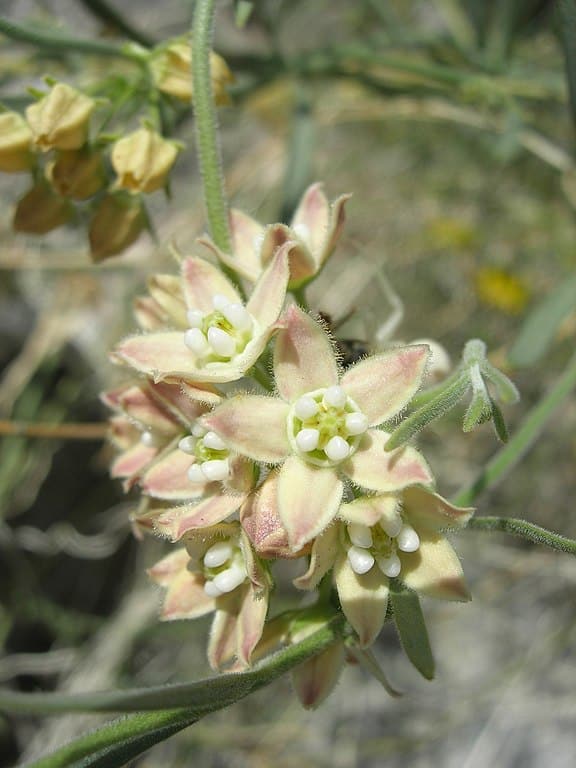
The hairy milkweed has narrow leaves and blooms in early or mid-spring.
©joedecruyenaere / CC BY-SA 2.0 – License
| Hairy Milkweed | |
|---|---|
| Scientific name | Sarcostemma hirtellum |
| Other common names | Rambling milkweed |
| Type of plant | Perennial, vine-like plant |
| Distribution | Southwestern United States, northwestern Mexico |
This aggressive, opportunistic plant grows in the desert regions of the southwestern United States and northwestern Mexico. It’s considered aggressive because it can grow on other plants, killing them while spreading.
The hairy milkweed has narrow leaves and blooms in early or mid-spring, revealing clustered flowers of over 13 florets.
10. Western Water Hemlock
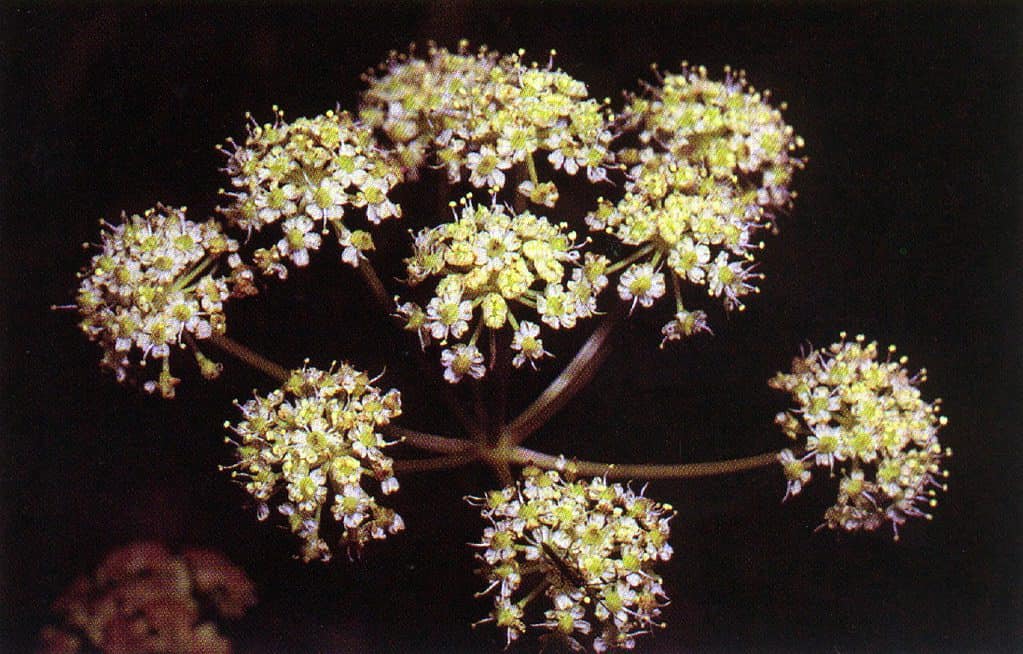
The western water hemlock is the most poisonous plant on the North American continent.
©Robert H. Mohlenbrock / Public Domain – License
| Western Water Hemlock | |
|---|---|
| Scientific name | Cicuta douglasii |
| Type of plant | Perennial plant |
| Distribution | North America |
The western water hemlock is the most poisonous plant on the North American continent. It contains cicutoxin, a yellowish liquid found in the plant’s roots that affects the central nervous system. Cicutoxin poisoning causes nervousness, incoordination, excessive salivation, tremors, seizures, and respiratory failure. It is poisonous to both humans and animals.
In short, this is the plant you want to avoid in Nevada, and we’re here to help you identify it. The western water hemlock emerges in spring and gives off an appealing odor, making it highly attractive to nature enthusiasts and animals. The plant grows in meadows, ditches, marshes, and stream banks. It has tall, purple-spotted stems, alternate leaves, and small white flowers.
11. Utah Vine Milkweed

The Utah vine milkweed is a rare plant growing in the Mojave Desert.
©Stan Shebs / CC BY-SA 3.0 – License
| Utah Vine Milkweed | |
|---|---|
| Scientific name | Cynanchum utahense |
| Other common names | Utah swallow-wort |
| Type of plant | Flowering perennial |
| Distribution | California, Utah, Nevada, Arizona |
This small vine is a rare plant growing in the Mojave Desert. People often call it the Utah vine milkweed or swallow-wort.
Its stems are short, reaching only 3.2 feet tall, and it can only grow if it has other shrubs or trees around that can support its development. The leaves are narrow and small, measuring a few inches long, while the flowers have a distinctive color, becoming bright yellow or orange when in full bloom.
Up Next:
- Longest Biking Trail in Nevada
- Discover the Lowest Point in Nevada
- The 5 Best Places to Camp in Nevada this Summer
- Discover The 10 Largest Animals In Nevada and Where You’ll Find Them
The photo featured at the top of this post is © Bill45/Shutterstock.com
Sources
- Wikipedia, Available here: https://en.wikipedia.org/w/index.php?title=Category:Flora_of_Nevada&pageuntil=Lupinus+meionanthus#mw-pages
- Wikipedia, Available here: https://en.wikipedia.org/wiki/Nevada
Thank you for reading! Have some feedback for us? Contact the AZ Animals editorial team.







